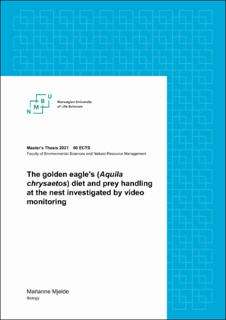| dc.description.abstract | A parent bird provisioning for its nestlings faces many decisions, which are important for the nestlings' survival. As the nestlings grow older, their needs and demands may change, and the parent may respond to this by altering prey selection and handling of prey before delivery at the nest. I investigated the diet and components of the breeding behaviour of the golden eagle (Aquila chrysaetos) at the nest. Previously, the breeding diet has mainly been researched by collecting prey remains and pellets, which is largely biased. By video monitoring, the breeding diet will be estimated more accurately, and one can investigate more variables and behaviours at the nest. In this study, one golden eagle's nest in Norway was video monitored during the breeding season, from the 19th of May to the 29th of August in 2020. The breeding diet of the golden eagles consisted of 88.5 % avian prey. Mountain hares (Lepus timidus), thrushes (Turdus spp.), and ptarmigans (Lagopus spp.) were the most abundant prey in quantity and gross mass. The probability of decapitation decreased with nestling age, plucking increased with gross bird mass, and the probability of a prey being partly eaten decreased with nestling age and increased with gross prey mass. The delivery pattern of the golden eagles had one peak during the day and a probability of delivery higher than random between 09:00 and 16:00. The number of delivered prey items per day increased with nestling age, while the net delivered prey mass did not. As the female resumes hunting, the number of prey delivered will increase, but a decreasing prey mass likely cancelled the corresponding increase in delivered prey mass. The gross prey mass decreased with nestling age, and the male delivered smaller prey than the female. Also, the male had a less decreasing probability of delivering smaller prey than the female as the nestlings grew older. The probability of a delivered prey being a thrush increased with nestling age, and the male was more probable of delivering a thrush than the female. As the nestlings grew older, the female had a larger increase in the probability of delivering a thrush than the male. The probability of the nestlings handling prey unassisted increased with nestling age and decreased with net prey mass. When the nestlings were handling unassisted, the handling time increased with net prey mass. The gross handling time increased if none of the nestlings monopolised the prey. The probability of the nestlings swallowing a prey whole decreased with nestling age and net prey mass, and the probability of them plucking a bird increased with nestling age. During the nestling period, the largest nestling handled more prey mass than the smaller nestling. My study support that the golden eagle has a broad diet, which also changes through the breeding season to enable the nestlings to handle prey unassisted. | en_US |

